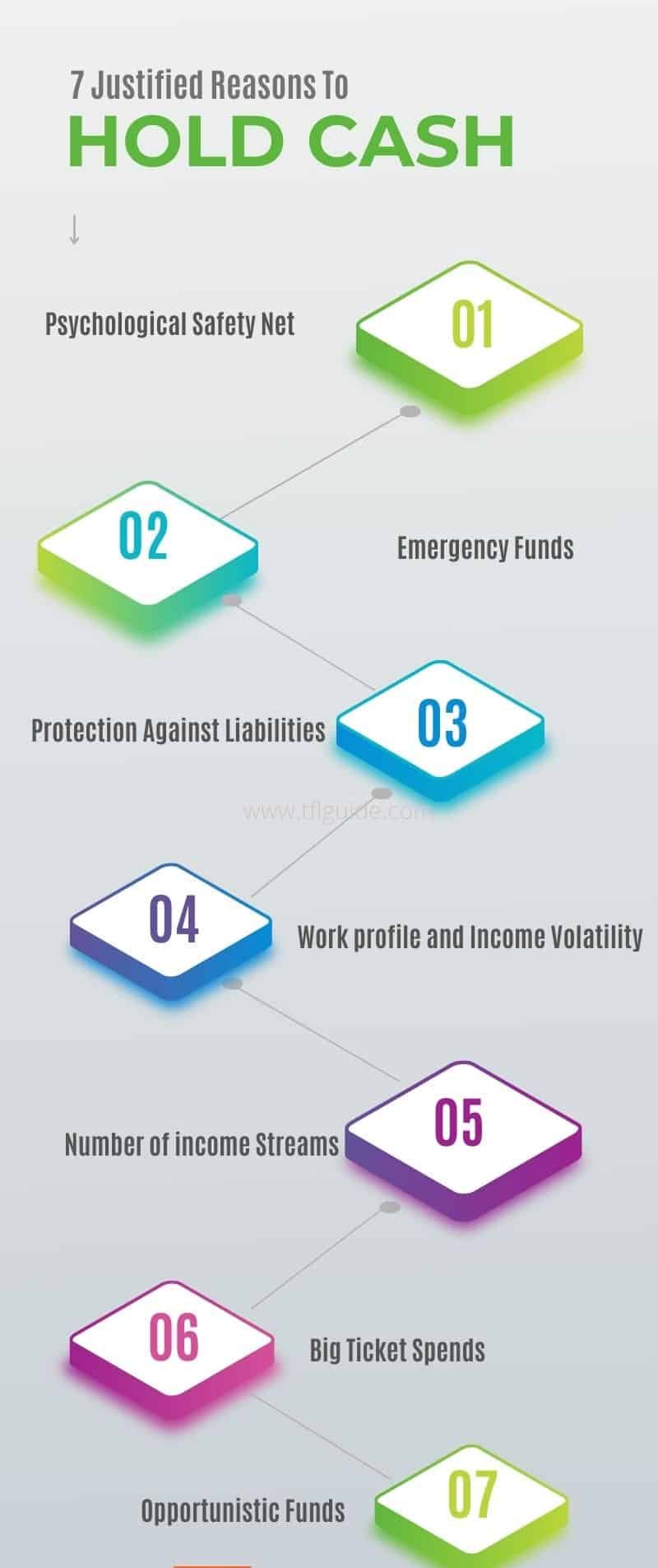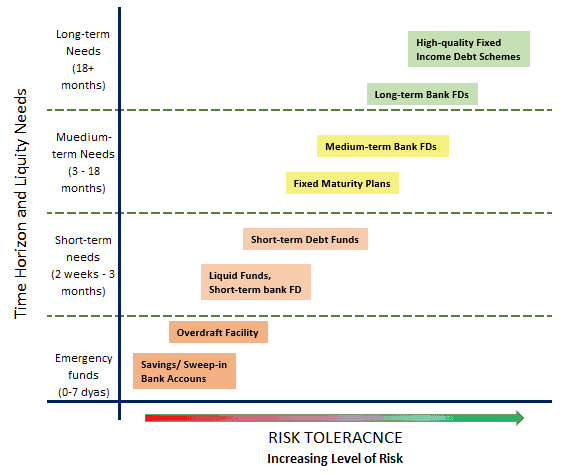Is it even possible to hold too much cash?
Suppose you are in your 40s, earning upwards of 30-lakh per annum, lead a healthy lifestyle, have your own home, and manage your finances well. You happen to have a decent financial portfolio of mutual funds and stocks for retirement, kids’ education and marriage, and an emergency fund.
Your family is adequately covered by life, health, and property insurance. And you happen to have 8 to 10 lakhs in your savings bank accounts, just in case. The picture seems perfect and all rosy.
But wait, there is just one thing that is put of place in this near-perfect picture. And you guessed it right – you are holding too much cash in your accounts.

Check- Saving for Retirement
But is it even possible to hold too much cash?
Isn’t cash IS the King?
And when you don’t have great avenues of investments, shouldn’t you sit tight on cash?
Yes, Yes, and Yes.
The notions that cash is king and sitting on cash and doing nothing are thumb rules, that have to be read in the context of another thumb rule:
Too much of anything is injurious to health!
Why Cash piles up?
There are multiple reasons – both acts of commission and mostly omission or inaction on our part – that result in the cash piling up. Some of them are:
- The recent sale proceeds of a property are not yet invested in another property or specified bonds.
- Received bonus or incentive.
- Got lucky on some deal and made a huge profit.
- Received a gift from parents or parents-in-law.
- Maturity amount of a moneyback insurance plan.
- Sold shares and mutual funds to book profits as markets zoom.
The current scenario of uncertainty has altered the perspective of many people and they are keeping cash to invest later in ‘safe’ fixed income instruments. But the problem with this approach is that you are relying on too many external factors that you cannot anticipate, predict, and control.
Cash and your portfolio
Sitting on cash may be a blessing as well as a curse for the health of your financial portfolio. The correct answer would depend on many factors:
- Mode of cash holdings.
- Size of the emergency fund and alternate sources of cash.
- Reason(s) for holding cash.
- How far away is your short-term goal.
- The quality of your medium- to the long-term portfolio.
The problem of holding too much cash mostly comes because far too many investors have no clue how much is their monthly expenditure and how much are their annual expenses. They cannot make budgets and plan ahead for the next few weeks, let alone months or years. And they don’t have the faintest of ideas about inflation, interest rates, and opportunity costs.
Such investors, generally, take impulsive decisions and when they burn their fingers, find solace in cash!

Read- How To Earn Money From Credit Card in India?
7 Justified Reasons to Hold Cash!
-
Psychological Safety Net
This one is tricky as this is the amount of cash that will help you sleep better at night. As every person has a different mindset, this value also changes.
-
Emergency Funds
Nevertheless, you should have liquid assets to cover three months of regular expenses (husband-wife both earning), and at most twelve months (retired). Therefore, for a family with monthly expenses of Rs. 50,000/month, you must hold between Rs 1.5-lakhs and Rs 6-lakhs in cash or liquid assets.
-
Protection Against Liabilities
If you and your family are protected, financially, against major setbacks like health emergencies, or the sudden demise of the earner, your cash requirements may come down significantly.
-
Work profile and Income Volatility
People working in sectors like real estate, cyclical commodities, etc. require more cash holdings to tide over long lean seasons compared to steady sectors like baking or FMCG. Professionals, small business owners, and people working in high-risk environments require more cash and equivalents.
-
Number of income Streams
For families solely dependent on a single income stream, more cash holdings are required. But if your family income comes from multiple streams – like a working couple, a small side business, rental income, etc. – then your cash requirements may reduce significantly.
-
Big Ticket Spends
If you are planning for a big spend in the coming few months – higher education, marriage, purchasing real estate, etc. then it is better to have good reserves in cash and equivalents and protect the capital.
-
Opportunistic Funds
With sufficient cash-in-hand, you can ‘time’ the market – like the market crash of March 2020 presented exactly such an opportunity. But this must be accompanied by a strategy to liquidate your holdings as markets become expensive. (be frank lot of people hold cash for this reason and most are not able to utilize funds when there’s blood on the street)
Check – Personal Finance Lessons from the Olympics
How Much Hold Cash is enough?
The filtered wisdom of decades of financial planning with all classes and types of clients suggests having cash holdings sufficient to meet your short-term requirements, that do not interfere with your long-term goals.
Just like insurance is a necessary expenditure, that you never wish to recoup, holding cash with negative returns also falls in the same category. That is why contemplating the just “right” amount of cash is extremely personal.
How to Hold cash?
Of your cash holdings, you can further carve out multiple buckets based on the liquidity of the asset – cash-in-pocket being the most liquid and others less so.
To help you make the decision based on sound reasons, we recommend a laddered or buckets-based approach:
- Define requirement buckets based on the urgency of the situations from a few hours to a few weeks, and so on.
- Identify Are You Holding Too Much Cash? would be needed for each of them – always consider a little worse than the average scenario.
- Find the right instruments that give you the comfort of the liquidity within the said window, with the safety of capital.
- Invest adequate cash in each bucket and move the balance funds up the ladder in the next bucket.
- Review and rebalance every six months.
The following diagram demonstrates the laddered approach.

Flexi/Sweep-in Savings accounts
Suited for: Immediate Liquidity
Returns: Low to moderate
Risks: No capital risk, but inflation risk
Cash-in-hand and savings accounts can meet your urgent needs within a few minutes to a few hours.
Most banks today offer an automatic sweep-in facility where your excess bank balance, above a threshold, is automatically converted into a short-duration FD for higher returns. If you make a withdrawal of an amount more than the threshold, the requisite amount is automatically transferred to your savings account with accrued interest.
Check – 8 Most Important Mutual Fund Questions
Overdraft facility
Suited for: Immediate Liquidity
Returns: Negative
Risks: None
If your bank offers you an overdraft facility, then avail of it. You will be charged only for the amount and period (in days) for which you actually took an overdraft and made a withdrawal. It can help you keep the cash balance at a minimum and earn superior returns.
Liquid funds
Suited for: Liquidity in 6-72 hours
Returns: Savings < Liquid Funds < long-term FDs
Risks: Interest-rate risk and credit risk
Liquid funds invest in overnight money markets and very short-term debt instruments maturing under 30 days. Their returns are better than the savings account but equal to less than the fixed deposits. These funds help you make your money work for you every day and capital is also relatively safe.
Short-term Debt Funds
Suited for: Liquidity in 2-12 weeks
Returns: Equivalent to or better than short-term FDs
Risks: Low-interest rate risk, but higher credit risk
Once your cash, Flexi account, and liquid funds buckets are full, you must choose short-term debt funds that hold the paper with 1-3 years maturity. This allows them to generate better and stable risk-adjusted returns They are also not much affected by changes in interest rates.
Fixed Maturity Plans
Suited for: 3-12 months
Returns: Moderate and steady
Risks: Low interest-rate risks, higher credit risk.
As the FMPs are closed-ended funds, with fixed investment and redemption dates, and invest in high-quality bonds of similar duration to hold them till maturity. The returns are steady and pre-defined, just like bank FDs, and can give moderate or slightly better returns than an FD.
Medium-term FD
Suited for: 6-24 months
Returns: Moderate and steady
Risks: Low interest-rate risks, low credit risk.
Medium- and short-term bank fixed deposits can offer the best security against capital/credit risk with moderate returns. If they are not used until their maturity, it is better to roll them over for a similar period.
Long-term FDs
Suited for: 18-36 months
Returns: Moderate and steady
Risks: Low interest-rate risks, low credit risk.
Long-term fixed deposits – with banks as well as highly rated corporates (like housing finance companies) – offer protection and returns that are equivalent to inflation. In real terms, you will earn zero to positive returns.
Excess Funds for Long-Term Investing
Holding cash in different forms can help you reduce the negative returns from the all-cash strategy. It can also expose you to a more systematic way of managing funds and reviewing needs in a more objective manner.
Once all your short-term buckets are full, you can use any leftover cash to add value to your long-term portfolio of equity and long-term debt (like PPF). You can also use the liquid funds to temporarily park extra funds and systematically transfer from them to an equity fund.
In case if you would like to talk about your Goals & Financial Fitness – Let’s have a Call
Please share in the comment section. What percentage of your financial assets are in cash or liquid instruments and why?